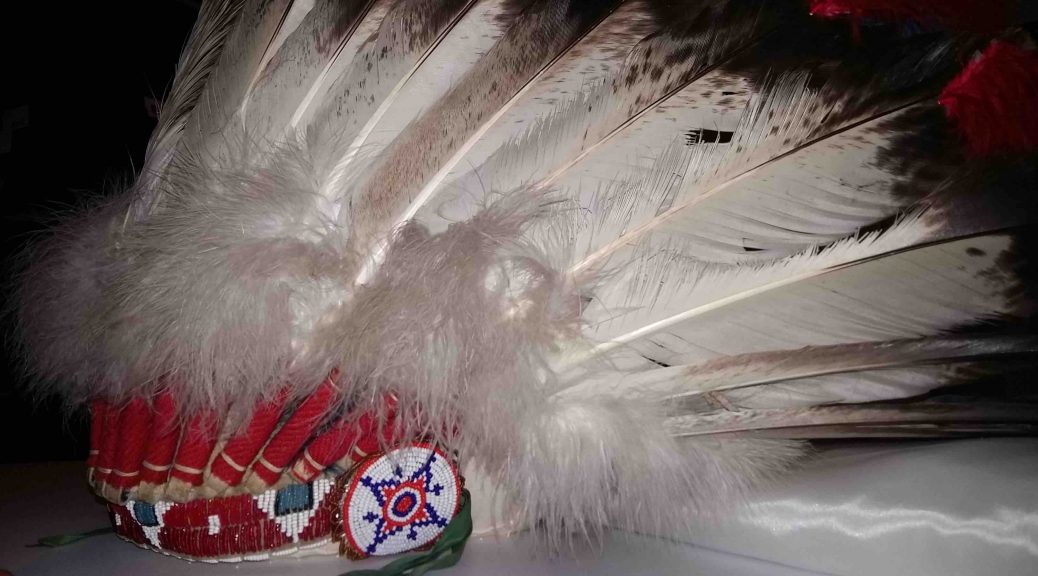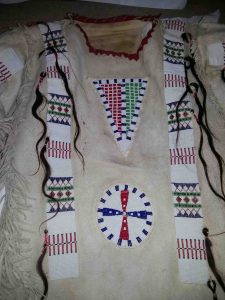
Nashville (2). Joyful Humbug: Churchill’s “Indian Forebears”
Many of the Churchill family down at least through Sir Winston’s grandson believed that American Indian blood ran in their veins. Remarks to the Churchill Society of Tennessee, Nashville, 14 October 2017. Continued from part 1….
“Mama is part red Indian…”
No exception to the family belief (until she saw contrary evidence) was Churchill’s daughter Mary. “I remember my daughter Emma, playing with her friends,” Lady Soames recalled. “Suddenly she warned them not to misbehave. ‘Mama, you know, is part red Indian, and if we are naughty she will go on the warpath.’” The Churchills had adopted an old legend that Indian blood ran in their veins.

In 1963 the National Congress of American Indians named Sir Winston Churchill “Chief Ba-ja-bar-son-dey,” which means “Great Leader of Men.” They sent him the battle costume and headdress of a Sioux warrior, “Chief White Man” suitably enough, from South Dakota.
The tunic is of buffalo hide. It bears the remains of enemies killed in battle. Carefully preserved at Chartwell, it has strands of attached black hair, most likely from scalps, but only a few drops of dried blood: Chief White Man was evidently a dexterous scalper. (Chartwell’s devoted staff provided these photos for my book. The artifacts are too fragile for open display and are carefully stored.)
The family held a firm belief. Their Iroquois blood came from Sir Winston’s mother Jennie’s maternal grandmother, Clarissa Willcox, who (like Jennie) had a dark complexion. Exactly how this transpired no one ever precisely defined, but there was no doubt that they broadly accepted the idea. The rumor had a life of its own—perhaps because it was fun for the Churchills to believe.
“Damned cheek!…”
Randolph Churchill, who began the great biography Hillsdale College is now finishing, loved the story, and even embroidered it. Flying once into Johannesburg, Randolph was incensed by an immigration form asking him to state his race—an important matter in Apartheid South Africa. “Damned cheek!,” he shouted, and began writing furiously:
Race: human. But if your object is to determine whether I have coloured blood in my veins, I am most happy to be able to inform you that I do, indeed, so have. This is derived from one of my most revered ancestors, the Indian Princess Pocahontas, of whom you may not have heard, but who was married to a Jamestown settler named John Rolfe.
Churchill genealogist Elizabeth Snell cut through all this joyful humbug when she revealed that Clarissa Willcox’s mother, Anna Baker, was the daughter of Joseph Baker and Experience Martin, children of English settlers, who married in Massachusetts in 1760. Logically, Mrs. Snell asked, do we accept family legend? Or do we accept “the simple, forthright facts as recorded by Anna’s colonial family in their probate records”?
Randolph’s insistence extended to his son Winston. In the 1990s after he’d published a book of his grandfather’s speeches, my wife and I drove Winston to see Plimouth Plantation in Massachusetts. There we encountered an Indian (or a staffer dressed like one). Winston popped out of the car and introduced himself. “You know,” he said, “we might be related!”
Back in the car I said, “Winston, you’re as Indian as my cat.”
“Never mind,” he retorted. “It’s my story and I’m sticking with it.”
Tall Tales continue…
…when Churchill enters Parliament. As President of the Board of Trade, he seals the fate of the Titanic. As Home Secretary he interferes with police battling anarchists in Sidney Street, sends troops to smash striking Welsh coalminers, and fights against Irish independence.
And then there’s the silly canard that Churchill was a lifetime opponent of votes for women. Continued in Part 3…
Winston Churchill, Myth and Reality is now available in paperback, with a lower price for the Kindle edition. Click here.






